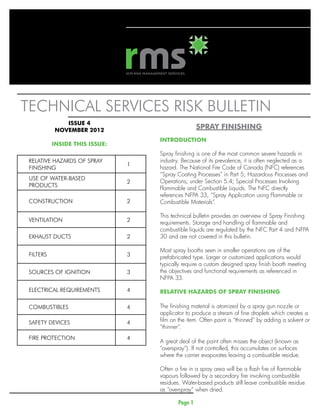
Rms Risk Bulletin Nov 12
- 1. Technical services risk bulletin ISSUE 4 NOVEMBER 2012 SPRAY FINISHING INTRODUCTION iNSIDE THIS ISSUE: Spray finishing is one of the most common severe hazards in RELATIVE HAZARDS OF SPRAY industry. Because of its prevalence, it is often neglected as a 1 FINISHING hazard. The National Fire Code of Canada (NFC) references “Spray Coating Processes” in Part 5; Hazardous Processes and USE OF WATER-BASED 2 Operations; under Section 5.4; Special Processes Involving PRODUCTS Flammable and Combustible Liquids. The NFC directly references NFPA 33, “Spray Application using Flammable or CONSTRUCTION 2 Combustible Materials”. This technical bulletin provides an overview of Spray Finishing VENTILATION 2 requirements. Storage and handling of flammable and combustible liquids are regulated by the NFC Part 4 and NFPA EXHAUST DUCTS 2 30 and are not covered in this bulletin. Most spray booths seen in smaller operations are of the FILTERS 3 prefabricated type. Larger or customized applications would typically require a custom designed spray finish booth meeting SOURCES OF IGNITION 3 the objectives and functional requirements as referenced in NFPA 33. ELECTRICAL REQUIREMENTS 4 relative hazards of spray finishing COMBUSTIBLES 4 The finishing material is atomized by a spray gun nozzle or applicator to produce a stream of fine droplets which creates a SAFETY DEVICES 4 film on the item. Often paint is “thinned” by adding a solvent or “thinner”. FIRE PROTECTION 4 A great deal of the paint often misses the object (known as “overspray”). If not controlled, this accumulates on surfaces where the carrier evaporates leaving a combustible residue. Often a fire in a spray area will be a flash fire of flammable vapours followed by a secondary fire involving combustible residues. Water-based products still leave combustible residue as “overspray” when dried. Page 1
- 2. use of water-based products ventilation The industry standard is to use NFPA Standard No. 33 A proper ventilation system with proper fan size is required. to analyse spray applications unless other ordinances are enforced in the “jurisdiction of authority”. A fan motor should not be inside a duct or located in an area subject to accumulation of residue unless listed for such Construction applications (normally fan motors are not). Construction of spray booths should preferably be of smooth sheet steel construction with all parts being non- combustible. Masonry or concrete construction is allowed however the rough surface of these materials allows for the accumulation of combustible residue. The floor of a spray booth should be made of a non- combustible, non-sparking material. exhaust ducts Exhaust ducts should be provided for booths with filters. Buildings with combustible construction should have exhaust duct extending 1.8m (6ft) beyond the exterior wall of building. Page 2
- 3. filters Sources of ignition Dry baffles: There should be no smoking, open flames, spark producing equipment or exposed surfaces exceeding the Tilted baffle plates change the air direction in the booth. ignition temperature of the material being sprayed within This causes the paint to deposit on the baffles rather than 6.1m (20ft) of any spraying area and no arc or gas go through the openings between them. The baffle plates welding within 15.2m (50ft). are removed for cleaning. This type of system is 70% effective. The Canadian Electrical Code is law in Canada. It should be used in making recommendations on electrical Dry filters: equipment for all hazardous locations including in and around spray booths. May be in the form of removable filter pads or mechanically advanced filter rolls. This type of system is approximately 80% efficient. Water Wash: A constant stream of water flows down a steel curtain at the back of the booth. Overspray passes through this water on the way through ventilation system. Water extracts droplets and washes them into a tank where they are filtered out. This type of system is 90 to 95% effective. Page 3
- 4. Electrical requirements combustibles There are complex electrical requirements which depend A clearance of 0.9m (3ft) should be provided to nearby on the type of material being sprayed, type of spray combustibles. room or booth (i.e. open or enclosed), vertical and horizontal distances to electrical equipment, etc. Ductwork should have a clearance of 457mm (18”) to combustibles through roof and extend a minimum of 1.8m Sealed light fixtures are required. (6ft) above the roof. Fan motor must be kept outside duct and booth. safety devices Ventilation equipment should be interlocked with spray equipment. fire protection Automatic sprinkler protection or fixed extinguishing systems. A portable fire extinguisher located near each booth. Page 4
- 5. risk management services corporate headquarters office Location 150 Commerce Valley Drive, West Markham, ON L3T 7Z3 For additional copies, please contact: Bernadette Corless E-mail: bernadette.corless@scm.ca Page 5